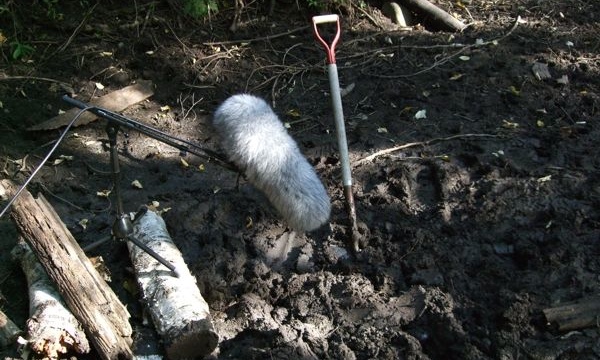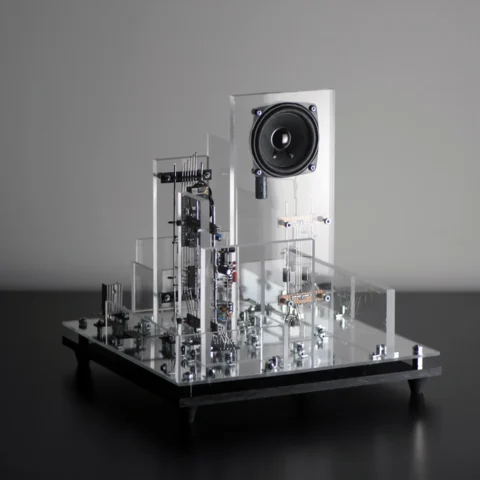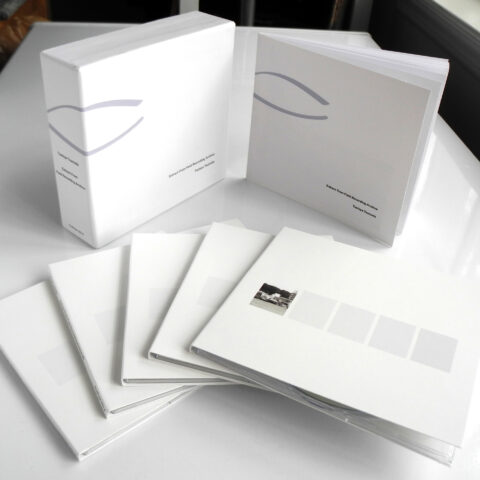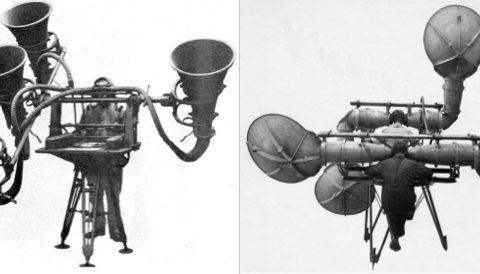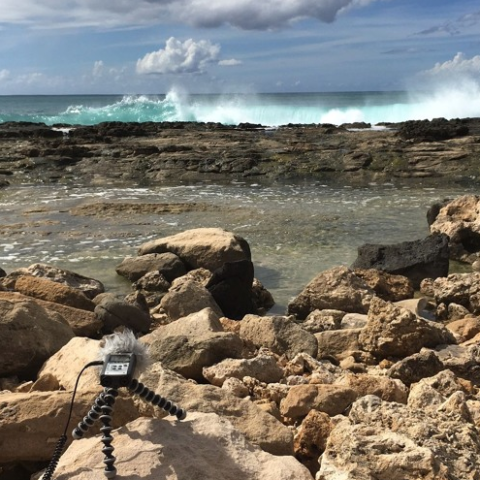Sound designer and recordist Frank Bry is releasing a new sound effects library today, packed with 464 mud recordings. We invited him to do an exclusive article about the making of the library and how he recorded the sounds.
Making of The Recordist’s Ultimate Mud SFX Library
Recording the Ultimate Mud SFX Library was quite an experience. I’ve always wanted my own mud splat or “Giblet” library. The term Giblet comes from working on fantasy type video games where monsters get slayed by the player and they explode into a bunch of pieces. Dungeon Siege 1 and 2 had a lot of these types of sounds. Back in 2001, I did record some mud, but I was so busy working on the game that it was a quick session just to get what I needed. So here I am in 2010 thinking about recording a brand new set of High Definition mud sound effects. After deciding that mud sounds were going to be my next project, I asked myself, “Where the heck do I record mud?” It just so happened that I had a mud bog on my ranch even though I did not realize it at the time… until I started planning.
The Planning

I have never been much good at planning. My life and work seem to flow quite well without too much future planning. Why plan when things can just happen? Well, I realized that the planning partner I had to work with for my mud library was Mother Nature. I have a seasonal stream or “creek” as they call them out West. This creek usually only dries up in July and August. Down at the bottom of a very steep hillside below my house there is a man made water retaining pool in a relatively level section of the creek. I think it was built a long, long time ago to either keep the water table up in the creek or for farm animals. It’s about 20 feet across and 5 feet deep in the center. I noticed that quite a bit of dirt, leaves, and sludge had built up over the years. I had my place to try and record some mud. This was a strange weather year. The creek had not stopped flowing and it was mid-July. The snow pack in the high mountains had long melted off. We did have quite a bit of rain early this summer so maybe that was the reason for the continuous flow in the creek. Who knows? Mother Nature is totally unpredictable up here in Idaho.
The first thing I had to do was get rid of the small waterfall that fed the mud bog. Since the creek was still flowing, I had to eliminate this source of noise. I could not get the tractor in close enough so I had to do it by hand. (Oh boy…fun!) Next problem was the pond was still fairly full of water. Since there was too much water for mud sounds, I recorded some water splashes. (A whole other story.) By early August the water had drained out and this thick, smelly, black mud was left. Pefect! The deer walk around in this mud bog so who knows what else is in there. Third issue was how the heck do I get a mic down in close without holding it in my hand? The edges of the mud bog were fairly steep so I had to use rocks and logs to create a level spot to place the mic stand and boom on. The Sanken CSS-5 is kind of heavy so I had to use rock counter weights to make sure the microphone did not do a “face plant” into the mud. But before I set that up, I decided to get the hand held mic recordings done.
The Recording
I recorded Ultimate Mud over a two-month period and had about 10 recording sessions, two of which were in the safety of my front yard with a wheelbarrow. I started with the Audio Technica AT-835ST and SD-702. I really like this mic for some things. It’s very bright and light so using in a pistol grip is really easy with barely any handling noise. I set it to the Narrow setting and walked around in the dry mud in the pond. There was water under the mud, but after stomping around a bit it came to the surface. I was able to get some great air suction sounds along with some incredible slimy squishes. I held the AT-835ST really close to my mud boots and after listening back, I was not sure what the hell I recorded. It seemed almost creature like…it had a voice!
Next up on the boom stand was the Sanken CSS-5. I did not want to use the pistol grip with this mic and risk dropping it in the mud. It’s heavy; handling noise is always an issue when you are trying to perform in the mud. Believe me, having both feet in 10 inches of thick, heavy mud is hard work. Anything can happen…and it did. More on that later. Once I was fairly sure the CSS-5 was secure in its position, I began recording more foot suction and splats and plops using a shovel. Remember, mud is pretty heavy so I got a work out! Some of the best air suctions and gurgles were from this session.
I continued on for a few more weeks with this set up. I recorded more shovel splats and had some fun with a five gallon bucket. I slammed the bucket, open end down, into the mud. The mud and air shot out like crazy. Mud flew everywhere, on the mic and all over me. Oh yeah, we’re really having fun now!
Rain, lots of rain, came in one week and filled the mud bog with water. The pond was full again. I had been planning to get the tractor in the mud to see if I could do some BIG mud splats because shovel splats are for wimps! This rain ended up as good fortune actually. Just leave the planning to Mother Nature. Getting the tractor up into the mud bog was no easy feat. I had to dig down the edge of the bog enough to position the tractor bucket over the bog. I had loosened up the mud enough to be able to scoop some of it up and get it into the tractor bucket. Once the bucket was full, I lifted it as high as I could and let it rip! The mud had settled to the bottom of the tractor bucket so I dumped out the muddy water first and then hoped for some colossal mud splats. It worked so well that I did one more take. I also recorded with my Sony PCM-D1 as a back up and alternate take and is included in the library.
Now it was mid-September and Fall was here. The leaves were turning and would soon start falling off the very large trees near the bog. These leaves are so big that they sound like sand being thrown onto the hood of a car. I had to get back down in the bog and finish what I started. Most of the water had drained out so I could do some drier, colossal mud splats with the tractor. I also recorded some mud footstep foley and squishes with my brand new Sennheiser MKH-416.
Last but not least, I needed some mud bubbling sounds. I enlisted my trusty wheelbarrow and some soil from the garden and mixed up some goop to mess around with. I remembered that every time I turned on the water hose, the air that was in the hose was forced out first. I had tried to blow into a tube that I placed in the mud. It worked well but I wanted a longer bubbling mud sound. I used the following trick. I hooked up 150 feet of drained hose and turned on the spigot. At first it was all air but then water came out and filled the wheelbarrow. Perfect, worked like a charm. The final recording was of a garden hoe pulling and scraping the mud in the wheelbarrow, strange sounds but usable somehow, somewhere.
The Result
Beyond my expectations! Check out the library, it’s mud “Giblet” heaven. Some of the mud sounds like monster or creature vocalizations. The mud growled, skittered and made strange shrieky noises sometimes; the other sounds I’ll leave it up to the sound designer to determine. It’s crazy stuff; it has a life of its own. Use at your own risk of disgusting your clients.
What I Learned and Other Goof Ups
Playing and/or recording in the mud is messy business. I took more showers during those two months than I can count. Because the mud is probably more than just dirt and water, I was concerned about bacteria. Wild animals abound here in North Idaho and you never know who or what has been in the mud. I do remember seeing all kind of foot prints in the mud bog. Deer, raccoon, skunk, bobcat, geese, birds and human (mine I hope). Thankfully I did not get sick. I really tried to make sure the mud did not get anywhere near my face and wore gloves at all times.
Make sure the gear does not fall into the mud. I did not have any equipment accidents. Thankfully the recording equipment still works and is mud free. I did come close though. I was in the mud recording myself pulling my feet out of deep, thick mud with the CSS-5 on the boom stand over the mud. I got really stuck and fell to the side and almost knocked over the boom stand. It tipped, but I caught it just in time. After that I decided that I should get stuck further away from the mic stand. I included the take in the library with some profanity (not edited out).
Caveat: Do not try this at home. The professional depicted in this mud sound effects collection is a highly trained lunatic.

